You are welcome to look at the talkback but please consider that this article is over 16 years old before posting.
You are welcome to look at the talkback but please consider that this article is over 13 years old before posting.
RIGHT TURN ONLY!!
Gift of the Puella Magi
by Carlo Santos,

I feel a bit guilty about enjoying the Polar Bear Café anime after hearing how manga-ka Aloha Higa basically got screwed over by her own editorial department regarding the adaptation. This is what it means to be an artist or creator in the world today: being exploited by big business until you cry uncle. Just look at the poverty-level pay scale for manga-ka and animators, and it continues to boggle me why anyone would want to stay in this line of work. But I am thankful for those that choose to follow their passions and do so.
ARATA: THE LEGEND
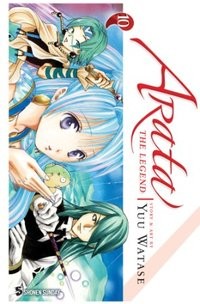
Vol. 10
(by Yuu Watase, Viz Media, $9.99)
FROM THE BACK COVER:
"In a world where humans and gods coexist, Arata is a member of the Hime Clan. One day, he winds up in the modern world and switches places with a boy named Arata Hinohara. Now while Arata acclimates to the life of a high school student, Hinohara sets out on a life-changing journey in an unfamiliar land...
While Hinohara visits the Hime clan, he is declared the second coming of a past king and the true ruler of Arata's world! Despite the many obstacles that fate puts before him, Hinohara forges ahead. But then, he encounters his strongest foe yet—the Shinsho Yataka!"
EVIDENCE FOR:
The best thing about Arata: The Legend is that it avoids the dreaded "one fighting move takes five chapters" pacing of many other weekly shonen series. Rather, this one covers plenty of varied ground in Volume 10: a trek across a desert, a couple of fast-paced sword fights, and escaping a vengeful tyrant's imprisonment. As exciting as that already sounds, there's even more to the quest than just dodging one peril after another: these adventures also come with a sense of humor, including a body-switch scenario that spirals madly out of control and a horde of host-club type gentlemen who turn out to be the main villains. Amusing as this is, however, Yuu Watase still has a well-planned story in mind: the newest adversary, Yataka, has a history that connects right back to principal character Princess Kikuri. The depth of Watase's imagination isn't just present in the storytelling, either; it also shows in the art with fantastical backgrounds (an airborne city and a "Lovers' Tree" are particularly striking) and carefully detailed costumes. (I'm still laughing inside about the host-club outfits.) Clean linework and layouts also make it easy to follow the dynamic, sword-slashing action scenes.
EVIDENCE AGAINST:
This adventure wends its way through many fights and challenges, but the most irritating thing about Arata is the way it uses arbitrary, magical plot devices to send the story in new directions. The initial body-switch is already a silly, random event in itself—but then another switch is thrown on top of that, and elevated to a major plot point, until you get the feeling that Watase is just tossing things in to make the story more and more ridiculous. That's not the only example, either: villain Yataka declares that his sword just happens to have another special power at the exact moment it would be most convenient to the plot, and body-switch magic gone haywire provides the perfect excuse for a flashback ("being stuck in someone's memory", as they call it). When the series isn't abusing the existence of magic to cover up for various plot holes, it's also making juvenile attempts at humor—how many times is body-switched Arata going to misguidedly grab his female companions' chests? The shallow, stereotypical characters are also a drawback: friends and foes all fit into handy epic-fantasy archetypes, with little else to make them memorable.
FINAL VERDICT:
Swashbuckling adventure and humor abound, but the story lacks true depth or logic—it's just tossing out one magical gimmick after another, leading to a disappointing C.
BLEACH
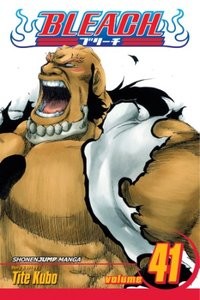
Vol. 41
(by Tite Kubo, Viz Media, $9.99)
FROM THE BACK COVER:
"Ichigo 'Strawberry' Kurosaki never asked for the ability to see ghosts—he was born with the gift. When his family is attacked by a Hollow—a malevolent lost soul—Ichigo becomes a Soul Reaper, dedicating his life to protecting the innocent and helping the tortured spirits themselves find peace.
Pushed to the verge of death by Ulquiorra, Ichigo releases his Hollow powers. But can Ichigo control his powers long enough to claim victory against his rival, or will he lose everything he's been fighting for...?"
EVIDENCE FOR:
If you wonder why people put themselves through the suffering of endless fights and zero story development, it's for moments like this. This is Bleach at its darkest, most terrifying, and most glorious—the hero literally becoming a monster in order to defeat the evil before him. It's not Ichigo's newfound strength, or speed, or even his magically flowing hairstyle that make this fight memorable: it's the fact that he could snap at any moment and become the ultimate villain, and you're just waiting to see ... what if. The final moments between Ichigo and Ulquiorra are especially poetic, revealing a glimpse of emotional vulnerability beneath all the macho-man posturing. But Ichigo's not the only one with dark surprises beneath the surface: the transformation of giant man-beast Yammy, and the powered-up form of aged Lord Barragan in Karakura Town, show that Tite Kubo always has another "wow" moment lying in wait. Of course, Kubo's stylish artwork is a key element in delivering such dramatic impact: Hollow-Ichigo is downright gothic and Berserk-esque in appearance, while full-page panels, dramatic angles, and masses of speedlines add to the intensity. In fact, this artistic praise applies to all of the battles going on.
EVIDENCE AGAINST:
Yes, they're all dramatic and amazing, but the fact there are still multiple battles going on is part of Bleach's problem. Even though Volume 41 stays focused long enough to finish out Ichigo and Ulquiorra's fight, it immediately snaps back into short-attention-span mode at the halfway point. Thus we get haphazard scenarios where someone like Rukia (anyone remember who she was even fighting against?) appears for a chapter, says a few words and shows off a cool attack, then disappears again for who-knows-how-long. Often these transitions happen at the worst possible time—like when Renji and his squad are about to take on Yammy, which looks really awesome and earth-shattering—and then it cuts back to Karakura Town, where all the less interesting Captains are fighting Aizen's advance forces (cue unpleasant memories of Volume 39, where they kept switching back and forth between about five different people). And of course, through all this there's barely any story or character development, aside from the bad guys stopping to explain their attacks with nonsense like the "Ten Causes of Death." Come to think of it, Ichigo's transformation is pretty illogical too. Everyone just powers up as much as they need to!
FINAL VERDICT:
Logic be damned, the finale of Ichigo's battle in this volume is a thrilling rush of adrenaline. Too bad the same can't be said for the chaos of all the other fights. This round of supernatural combat gets a B-.
FLCL
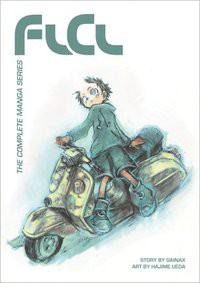
Omnibus Edition
(by Gainax and Hajime Ueda, Dark Horse, $19.99)
FROM THE BACK COVER:
"In this surreal sci-fi romp, a sullen Japanese boy finds himself in the middle of an interstellar conspiracy. As Naota Nandaba's already depressing home life unravels further, a sexy space assassin becomes his family maid, and his own head becomes a portal for armed robots. Life as he knows it is getting more and more confusing and violent, and he isn't sure who's friend or foe! One thing's for certain, though—it's time for him to grow up so that he can save his hometown from malevolent invaders!"
EVIDENCE FOR:
It's hard to believe FLCL originally came out a decade ago—but yes, there really was a time when it was the newest and weirdest thing ever, and this re-packaging of the manga reminds us what it must have felt like back then. With Hajime Ueda's sketchy, unconventional art style and a truly absurd storyline, this is one of those "modern art" pieces that is destined to be forever modern. As expected, the robot battles are the highlight; even the penstrokes they're drawn with seem to ooze raw alien energy. Meanwhile, the bizarre events of Naota's life are a perfect metaphor for adolescence: everything comes rushing in at a wild, uncontrollable pace, and you'd better be ready to deal with it no matter how confusing or infuriating it is. The panels, which vary in size and style and run the range from intense close-ups to epic zoom-outs, also capture this edgy, unpredictable feeling. And there's no moment more exhilarating than the final battle, which brings together all the previous robots (something the anime never did) and shows Naota finally taking control of his tumultuous existence. What an incredible thrill ride—and one that never gets old.
EVIDENCE AGAINST:
There are plenty of people who dislike FLCL because it makes no sense—and re-reading the manga will only reinforce their opinion. This is modern absurdism at its best, but it's also slice-of-life at its worst, where entire chapters might as well be called "Naota does stuff and other people do stuff and that's it." There isn't anything resembling conflict or plot advancement until about halfway through the book; everything before that is just Naota and the main characters hanging out and watching robots pop out of his head. Speaking of which, most of the robot battle scenes are as incomprehensible as the story—the visuals may be energetic and stylish, but are obscured by too many abstract lines and special effects to accurately show who's attacking who. Scenes of everyday life also have this problem to a lesser extent: people standing around in backgroundless space, muttering pseudo-philosophical lines to each other. Just imagine how confusing this must be for someone who hasn't watched the anime several times over. Between the obtuse artwork and crazy-quilt plot, it's impossible to connect with this story—it's all technique and concept, but no feeling.
FINAL VERDICT:
Yes, the anime is a work of mad genius—but this just imitates the craziness on an inferior level, earning a C (with most of the plus points going to the visual style).
PUELLA MAGI MADOKA MAGICA
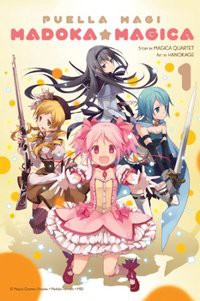
Vol. 1
(by Magica Quartet and Hanokage, Yen Press, $11.99)
FROM THE BACK COVER:
"When a new girl joins her class, Madoka Kaname thinks she recognizes the mysterious, dark-haired transfer student from one of her dreams ... a dream where she is approached by a catlike creature who offers Madoka an opportunity to change destiny. Madoka had always thought magic was the stuff of fantasy ... until she sees the transfer student fighting with the very cat-being from her dream! And just like in Madoka's dream, the cat gives her a choice. Will Madoka become a magical girl in exchange for her dearest desire? What will be the cost of having her wish come true?"
EVIDENCE FOR:
Just like in the anime, the sudden mood swing in the opening chapters of Madoka Magica manga is impossible to forget. It starts out so disarmingly innocent—Madoka and friends goofing off at school, mascot Kyubey smiling and playing around—but quickly dips into the dark undercurrent that made the series famous. Who needs evil villains when you've got soul-searching questions like these: What motivates you to help others as a magical girl? How much would you sacrifice to make a wish come true? The questions only get tougher when a split-second mistake reveals the true danger of this profession—and the pressure mounts on Madoka to choose her destiny. It would have been so easy to go the standard "fight witches, get money" route, but the emotional and philosophical challenges posed here are far more effective. The battles also work splendidly, with the alternate worlds designed by Gekidan Inu Curry still looking surreal as ever in black-and-white, while action scenes involving swordsmanship and gunplay make a strong impression on the page. Clean layouts and true-to-the-anime character designs also result in a smooth, fast-paced story flow.
EVIDENCE AGAINST:
It only takes one look to see that the artwork in the Madoka Magica manga is polished but lacking. Maybe it's the way backgrounds are practically nonexistent in the early chapters, or how the characters are sketched out in simple lines that are devoid of personality. Compare it to a classic magical girl series like Sailor Moon, where a single curved line can resonate with life—while this one falls back on dead-eyed moe expressions and cookie-cutter screentones. This dullness also means that some moments, like the Mami incident, lack the full impact that they could have had. And don't assume that the depth of the story can carry it when the visuals fail: often times the characters are just adding lots of verbal padding, nattering on for a whole page about the sadness of a magical girl's life when they could have said it in one panel. The story's desire to get into "the dark stuff" as soon as possible also means skimming on early character details, like Madoka's family life, even though those relationships drive the emotional rollercoaster to come.
FINAL VERDICT:
Deep thoughts and shocking events show plenty of promise, but the lack of artistic "pop" and sometimes shallow storyline leave this at a C+.
SAILOR MOON

Vol. 5
(by Naoko Takeuchi, Kodansha Comics, $10.99)
FROM THE BACK COVER:
"Chibi-Usa gets sucked into the far reaches of space-time and vanishes! It's up to Tuxedo Mask to reach her and get her back safely while Sailor Moon and the others must escape Nemesis and the evil clutches of Wiseman and his cronies. But as Tuxedo Mask travels through the space-time storm, he encounters an ominous woman claiming to be his daughter! Who is this strange woman? Is she really Chibi-Usa?!"
EVIDENCE FOR:
Volume 5 of Sailor Moon is easily the best of all the ones that have come out so far—a masterpiece that covers just about every emotion in the book. There are no cheap clichés or predictable plotlines in the finale of the "Black Crystal" arc, not when Naoko Takeuchi is pulling one twist after another in each chapter. From Chibi-Usa turning toward the dark side as Black Lady, to Sailor Pluto's heroic action, to the transformation of Sailor Chibi Moon, the story just keeps topping itself all the way up to the finale. Oh, and the bad guy is an entire planet—how does it get any more epic than that? Even the setting of the story makes an unforgettable impression, the way it combines high-concept sci-fi (sentient planets, interdimensional time travel) with the castles, kingdoms, and magical powers of the fantasy genre. Of course, ideas as grand as these call for equally grand artwork, and Takeuchi is up to the task with a barrage of special effects, screentone patterns and page-spanning battle poses. Delicate, flowing lines and sparkling lights somehow add up to incredible displays of galactic power—a contradiction that works because of how daring it is.
EVIDENCE AGAINST:
How complex is the Sailor Moon universe? So complex that the characters have to stop every few pages to explain in detail why everything works the way it does. Constant exposition is the dead weight that drags the series down, and at worst, it gives the impression that Takeuchi is just making stuff up in order to suit the story . "Oh, Sailor Moon wasn't able to transform for the past several chapters but now she can because she's standing next to an energy portal to her own world" ... okay then, if that's what it takes to make the laws of the universe work around here. Almost as bad is the dialogue where the characters talk about their feelings toward each other: Black Lady goes way overboard trying to express her resentments, and near the end comes a sugary, gag-worthy monologue where Usagi expresses her love for Mamoru. The visuals can be messy too, with battle scenes where special effects become more important than understanding the action. Sometimes the characters even look like they're floating in random space—which is actually true in some cases, but also looks like artistic laziness.
FINAL VERDICT:
Even if it seems overloaded at times, this volume still has all the right doses of epic, universe-saving adventure for a B+.

MIKU-4 (Mikuyon)
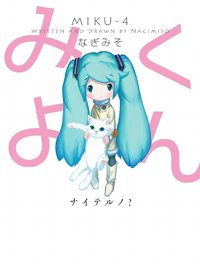
(by Nagimiso, East Press, ¥1155, $8.99 online)
FROM THE BACK COVER:
"A spin-off of the Vocaloid software 'Hatsune Miku,' this poignant full-length manga traces the personal growth of a quiet and timid young girl, Miku. For this publication, both the web serial and fanzine versions were substantially edited and revised, and the highly popular artwork is now displayed at a large scale, with four frames per two-page spread."
EVIDENCE FOR:
Contrary to all Vocaloid expectations, MIKU-4 has nothing to do with holographic projection concerts, internet memes, or squeaky electro-pop. Instead, this surprisingly touching story is about a young girl's emotional growth—a young girl who just happens to be the twin-tailed starlet of synthesized vocal music. Even though it's in four-panel format, don't expect dumb gags or mindless ramblings: rather, it's a continuous tale of Miku going on a road trip and touching the lives of others along the way. Older-generation Vocaloid characters Kaito and Meiko make a cameo, and instead of just being there for fun, they evolve into endearing mentors in the first story arc. Later chapters go even deeper, touching on the subject of mother-daughter relationships, the pain of death, and how even an android (which is how Miku is imagined in this story) can help heal emotional wounds. Soft, simple lines give the art a far more organic feel than what one usually sees among mainstream manga. In fact, the homegrown indie-comic vibe comes closer to artists like James Kochalka or Craig Thompson, with the dot-eyed characters and hand-drawn shading. It may be the story of a "virutal idol," but it's still very human deep down.
EVIDENCE AGAINST:
Sometimes, simpler isn't necessarily better, and MIKU-4's minimalist approach leaves the story feeling incomplete in some ways. The near-total absence of dialogue is an artsy touch, but there are times when a few lines of text would have helped flesh out the characters' feelings and personal motivations. The wordless storytelling makes it too tempting to race through the book, resulting in a shallow emotional journey even though the artist poured serious thought and feeling into it. Even the artwork itself, simple as it is, has some issues: when the story is still in gag-strip mode, some of the punchlines (which are already weak) depend on tiny little visual cues. Other times, the problem lies not with too little content, but with too many unnecessary flourishes: a brief appearance by fellow Vocaloids Rin and Len seems to have been thrown in there just because they exist, and a flashback near the end of the story adds detail to one of the characters but takes Miku out of the spotlight. The insertion of song lyrics into a couple of scenes is also unnecessarily pretentious and meaningless without music anyway.
FINAL VERDICT:
As a quick-paced single volume, it may not be worth the full sticker price, but the unique art and heartfelt drama do offer a different take on what Vocaloid characters are about.

It's always a little bittersweet getting a Reader's Choice about a discontinued series and realizing what you missed out on. Here's another little gem that never really got its chance to shine. Please welcome back Jean-Karlo and his review of this overlooked title—and to other readers out there, your reviews of discontinued series are welcome too!
SONG OF THE HANGING SKY
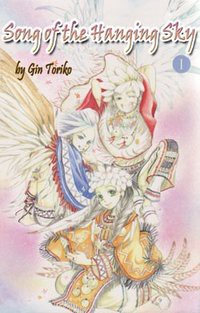
Vols. 1-2
(by Toriko Gin, Go Comi, $10.99 ea.)
It's World War II. A medic named Jack has decided to turn his back on the war and isolate himself in the European woods with a German Shepherd. His life changes, however, when he happens upon the last few Bird Men: humans with feathers and wings that are aesthetically and culturally similar to Native Americans. While the war rages on, Jack witnesses what could very well be the last days of the Bird Tribes.
It's a little hard to write a description that does Song of the Hanging Sky justice, not so much because of its concept, but its execution. Who would have thought that a story about a bunch of bird-people would have felt so human? Much like A Bride's Story, Hanging Sky is focused on The Bigger Picture: Jack may find himself knee-deep in the tribe's comings-and-goings, but he's only a witness to the events. The real developments center around the tribesmen: bird-boy Hello's growing rivalry with his best friend, Little Wolf; Chief Fair Cave's relationship with his wife, Honey Bee; the tragic reason for the Bird Tribe's diminished numbers ... Hanging Sky may throw a lot of oddly-named characters and titles at the reader, but it's hard not to care about any of them.
It's also hard not to be impressed by the artistic design. Again, much like A Bride's Story and its Nomadic trappings, Hanging Sky lays on the Native American motifs rather thickly. You'd think it'd be tough to take it seriously, what with characters that grow outrageously large feathers as hair, but somehow, Toriko Gin manages to make it all come together. The designs are eye-catching without being ostentatious, while also remaining unique and memorable—at their worst, they're still great cosplay fodder. Gin also takes great care that these characters live in a convincing wilderness. The cliffs, forests, and snowy fields of Europe are almost characters in-and-of themselves. The cover-art is gorgeous, too.
Unfortunately, only the first two volumes (of four!) were released in the United States. There were plans to release volumes three and four, but they fell through. What's more, Go Comi is dead and buried: a victim of the rise and fall of the Manga Bubble. Regardless, Song of the Hanging Sky's striking artwork and haunting story will leave an impact. It's a unique world with unique characters, and I'll gladly sing its praises until I'm hoarse. Strongly recommended.
Is there a hidden gem of manga you'd like to reveal to the world? Is there a piece of garbage that deserves to be bashed in public? Or is there a title that didn't get a fair grade here, and you want to set the record straight?
Now's YOUR chance to be the reviewer! Write a review of about 300-400 words (a little more or less is fine) and include:
- your name.
- Title of manga (and volume no., if applicable)
- Author/Artist
- Publisher
- Briefly describe the story, then explain why this manga is great, terrible, or in between. Be objective, but also be entertaining.
Then send it in to rtoreaders (at) gmail (dot) com (plain text format preferred). One review will be selected out of all the submissions and will be published in the next column. All types of manga and manga-inspired comickry are accepted, from past and present, from Japan and beyond—what matters is that it's the Reader's Choice! NOTE: Submissions may be edited for formatting and grammar.
discuss this in the forum (16 posts) |